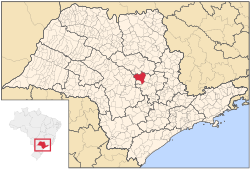Brotas is a Brazilian municipality located in the state of São Paulo. The population is 24,636 (2020 est.) in an area of 1101 km2.[2] The town is known locally for its coffee, on which its economy relies.
Brotas | |
|---|---|
 Location in São Paulo state | |
| Coordinates: 22°17′05″S 48°07′38″W / 22.28472°S 48.12722°W | |
| Country | Brazil |
| Region | Southeast |
| State | São Paulo |
| Area | |
| • Total | 1,101 km2 (425 sq mi) |
| Elevation | 647 m (2,123 ft) |
| Population (2020 [1]) | |
| • Total | 24,636 |
| • Density | 22/km2 (58/sq mi) |
| Time zone | UTC−3 (BRT) |
| Postal code | 17380-000 |
History
editThe city's history started in 1839 when a chapel was built which originated a settlement around it. Brotas became a district of Araraquara in 1841, then it became a district of Rio Claro in 1853. On August 22, 1859, the district was promoted to a municipality.
The municipality experienced its greater development era during the coffee farming expansion which occurred between the 1920s and the 1930s. During this era the city received a large number of Italian immigrants. Due to the coffee agriculture decline, a large number of Brotas' citizens migrated to larger cities.
The municipality contains 44% of the Itirapina Ecological Station, created in 1984.[3]
Economy
editDespite its coffee-oriented historical economic development, Brotas is known internationally for its specialization in adventure tourism, hosting the practice of several adventurous sports such as rafting and canoeing, taking advantage of the Jacaré Pepira River.
Nowadays the municipality's economy based in farming and cattle raising, especially in the culture of sugar cane and orange, despite the growing relevance of adventure tourism.
The municipality contains the strictly protected Mata do Jacaré Ecological Station on the south bank of the reservoir formed by the Santana Dam on the Jacaré-Guaçu River, which separates the municipalities of Brotas and São Carlos.[4]
The Brotas region, including the Patrimônio de São Sebastião neighborhood and the city of Torrinha, feature an elevated number of landforms of great interest for tourists.
Media
editIn telecommunications, the city was served by Companhia Telefônica Brasileira until 1973, when it began to be served by Telecomunicações de São Paulo.[5] In July 1998, this company was acquired by Telefónica, which adopted the Vivo brand in 2012.[6]
The company is currently an operator of cell phones, fixed lines, internet (fiber optics/4G) and television (satellite and cable).[6]
References
edit- ^ IBGE 2020
- ^ Instituto Brasileiro de Geografia e Estatística
- ^ ESEC de Itirapina (in Portuguese), ISA: Instituto Socioambiental, retrieved 2017-02-19[permanent dead link]
- ^ Feliciano, Ana Lícia Patriota; Santos, José Eduardo dos; Pires, José Salatiel Rodrigues; Cavalheiro, Felisberto; Moschini, Luiz Eduardo, CARACTERIZAÇÃO AMBIENTAL E PROPOSTA PRELIMINAR DE ZONEAMENTO DE UMA UNIDADE DE CONSERVAÇÃO..., archived from the original on 2009-12-01, retrieved 2016-05-12
- ^ "Creation of Telesp - April 12, 1973". www.imprensaoficial.com.br (in Portuguese). Retrieved 2024-05-26.
- ^ a b "Our History - Telefônica RI". Telefônica. Retrieved 2024-05-26.
External links
edit- Brotas Online.com.br (in Portuguese)
- Brotas.com.br (in Portuguese)
- Visite Brotas (in Portuguese)
- Viaje Brotas (in Portuguese)
- Turismo em Brotas (in Portuguese)


